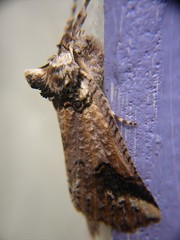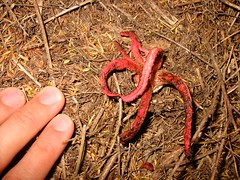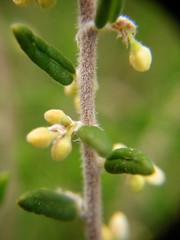We say on the
NatureWatch NZ website that it's built by NZBRN, the New Zealand Bio-Recording Network. In some ways it is. In a lot of ways, it's not: it's built by
you. We'd like to take a moment to explain some of the different ways that you can add and edit the content of
NatureWatch NZ. For example, did you know that you can add a common name for a species? Or, that you can add a link to an external webpage with more information about a species? Or, add a place to our map?
We'll start with some obvious things and ease on into things you might not have noticed yet.
Add observations
This is the obvious one. It's what
NatureWatch NZ is all about. You can add observations, comment on and correct the identifications of other users' observations, and add observations to
Projects. The more we fill
NatureWatch NZ up with observations, the more we learn about New Zealand biodiversity, and the happier everyone is (and wealthier, and better looking too).
Add projects
Projects are places in
NatureWatch NZ where like-minded (e.g., equally crazy) people can gather to share observations about just the species or place they most care about. If there's not the
Project you want,
you can create it. You can also invite other users to join it, and promote other users to administrators to allow them to also edit the Project settings.
Add places
Places in
NatureWatch NZ are named areas on our map. From our legacy system we have populated
NatureWatch NZ with lots of named points on the map, but since they don't have any area, they cannot generate species lists and observation lists. Only places with an area can contain observations. We're working behind the scenes on uploading lots of places with areas into
NatureWatch NZ. However, there's no need to wait, and we're never going to get every one of your special places. That's nothing to worry about because
you can create places yourself by drawing a polygon on our map, giving it a name, and saving it.
Every place you make becomes available for everyone else to use, and since it has an area, you'll get a list of all observations available in that place. You can even subscribe to a place (yours or someone elses' place) and get informed of all new observations made in that place. And, if you made a mistake or the place boundaries change, you can edit your place at any time.
 I can edit my places whenever I like, or even delete them.
I can edit my places whenever I like, or even delete them.
You'll also see that
NatureWatch NZ attempts to get photos from
Flickr and information from
Wikipedia about your place. If there's no information, or you want to add or edit it, you add your photos of the place to
Flickr (just be sure to tag them with exactly the same name as you gave your place) and you can log onto
Wikipedia to create or edit the page on your place (again, the place name will have to be exactly the same). If there's already a page on
Wikipedia with a different name, you can create a new page with your place name and have it re-direct to the existing
Wikipedia page. Wikipedia has instructions on how to set up a redirect page
here.
 All observations listed with Ernle Clark Reserve, a place I created in NatureWatch NZ.
All observations listed with Ernle Clark Reserve, a place I created in NatureWatch NZ.
 NatureWatch NZ attempts to find Flickr photos and Wikipedia information about your place. If it finds nothing, you can add to Flickr and Wikipedia.
NatureWatch NZ attempts to find Flickr photos and Wikipedia information about your place. If it finds nothing, you can add to Flickr and Wikipedia.
Fill in the Species Page
Now we start getting fancy. Every species in
NatureWatch NZ has its own page, which by default contains its taxonomy, a list of recent observations, a distribution map, photos from
Flickr tagged with that species' name, and whatever has been entered into Wikipedia about it. Let's go to the species page of your favourite species. Assume for the sake of this demonstration that it's
Austrosciapus proximus, a pretty little fly.
Wait, you haven't heard of it? Neither had I until today when user
Eve Manning uploaded
an observation of it along with some excellent photos.
Perhaps not surprisingly, clicking on the
Species Page link for
Austrosciapus proximus in NatureWatch NZ didn't give us much, beside the fact that its name is
Austrosciapus proximus, it's in the family
Dolichopodidae, and it's found in Mount Eden, Auckland (thanks to Eve's observation). If
Austrosciapus proximus really was you favourite species, you could add a lot more.
 A default NatureWatch NZ species page, in this case for a species without any Creative Commons copyrighted photos on Flickr and no Wikipedia page. It's a bit dull.
A default NatureWatch NZ species page, in this case for a species without any Creative Commons copyrighted photos on Flickr and no Wikipedia page. It's a bit dull.
For a start, there is no default photo, which means that the little icon next to the species throughout the site will just be our little butterfly icon (since it's an insect). It's better to select a few nice photos of it, the first of which will become the icon for this species across
NatureWatch NZ. To do so, just click "Add one" next to "This taxon has no default photo!". (If you don't see this, it means someone has already done this.)
After you're done adding a photo, be sure to click on it and make sure that it has a large size. If you're picking a photo from the Flickr photo browser that pops up, it is possible to pick photos that are too small and don't have a large size in Flickr. We don't want these as the first photo you choose or otherwise there will be an ugly blank photo on the species entry page banner when this species is randomly chosen for display. When choosing a photo from Flickr, it's also best to pop over to Flickr and try to track down photo(s) taken in New Zealand. The easier thing is to choose the best photos from already in NatureWatch NZ, when we have some, which in this case we do.
 You can choose photos for the Species page from Flickr, NatureWatch NZ, and EOL (the Encyclopedia of Life).
You can choose photos for the Species page from Flickr, NatureWatch NZ, and EOL (the Encyclopedia of Life).
 Here's the same page after we've selected some photos. It looks much more useful already.
Here's the same page after we've selected some photos. It looks much more useful already.
Notice that there is also no common name. If you know one, you can add it. You can also specify what language the common name is in, so you can add one or more English and Maori common names for the species. You can also edit any existing common names if there's been a mistake made. Any names you make will be available to everyone when they hit the Lookup button when they make their observations.
Landcare Research has a webpage on the species where they call it the small green long-legged fly. So we can click the "Add a name" link and add the name "small green long-legged fly", say it's a name in English, and press save. I did that earlier today so you'll see it when you visit
the page now. This is an Australian fly so won't have an Maori name, but if you knew one, you could add that too.
 No common name? There's a link for that!
No common name? There's a link for that!
 The NatureWatch NZ page for adding common names. Note that you can also select the language.
The NatureWatch NZ page for adding common names. Note that you can also select the language.
There's also no Wikipedia entry on this species. It's free and easy to log into Wikipedia and make the page, if you have the time and know something about the species. In this case, I don't, but all is not lost. I do know that there is a webpage on the species on the
Landcare Research website made by Leonie Clunie. I can help other
NatureWatch NZ users by adding this link to the
Austrosciapus proximus Species Page. Just click "Add a link" and add in the details. Bingo! One new link added to the page. You may notice there's a checkbox called "Show for descendent taxa". Only tick this if you're adding a link to a genus or family or other high level taxon and want the link to be visible on all species that it contains.
 If you know of good external webpages on a species, you can add the links to the NatureWatch NZ species page.
If you know of good external webpages on a species, you can add the links to the NatureWatch NZ species page.
 Adding a taxon link to the Austrosciapus proximus Species Page.
Adding a taxon link to the Austrosciapus proximus Species Page.
 Here's out new Austrosciapus proximus Species Page, complete with photos, a common name, and a link for more information.
Here's out new Austrosciapus proximus Species Page, complete with photos, a common name, and a link for more information.
So there you have it. If you see something that's missing or not quite right on
NatureWatch NZ, in most cases you can change it yourself. And that's a good thing.
NatureWatch NZ will become as good as
we can make, and
we includes
you.















































































